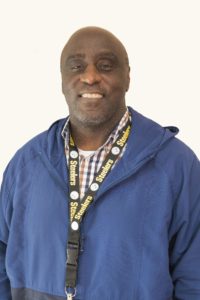For the past 10 years, Tony Haynesworth has been campaigning for service members, veterans and their families, to improve the patient-care experience, whether at a Department of Veterans Affairs healthcare organization or military treatment facility.
Haynesworth, now assigned as Landstuhl Regional Medical Center’s lead patient advocate, says decades of experience in customer service has led him to one conclusion: communication is key to better outcomes.
“You have to have a strong advocacy and that’s why we’re here,” said Haynesworth. “Sometimes when the patient can’t relay what their true feelings are or they feel they’re not being heard, we’re the folks that help bridge that gap.”
The Patient Advocacy Office serves as a liaison between patients or their families and the hospital staff. Advocates help find solutions to problems or misunderstandings, and assist with voicing concerns, obtaining timely and relevant information or offering compliments or suggestions to hospital staff. Haynesworth, a retired U.S. Army sergeant first class, served Soldiers for 22 years working in personnel departments and hopes to bring the patient perspective into hospital interactions.

“The Soldiers that are coming to you are customers, serve them with a smile,” said Haynesworth. “So it’s all the same (whether as a personnel Soldier or physician), you treat people how you want to be treated. (That attitude) translates into (hospital interactions) as well.”
For years after retiring, Haynesworth worked for military housing offices in Maryland before starting a new position as a congressional liaison for the Veterans Affairs and eventually landing a role as the patient advocate.
“(The VA healthcare director) thought it might be best to have somebody (as a patient advocate) who has been there, done that, just as the patients have, and may be able to relate more with (veterans),” said Haynesworth. “The answer may be what it is, but I may be able to help them have a better and full understanding of why the answer is (what it is).”
Although multiple factors influence the need for advocacy, patient advocates aim to promote or reinforce the needs of patients. During a recent visit to Europe, Defense Health Activity Director, U.S. Army Lt. Gen. Ronald Place, expressed the need for patient advocacy as the military treatment facilities transition toward joint-service environments, which may affect service members’ thoughts on their healthcare delivery.
“We have to standardize, where standardization makes sense, and eliminate unwanted variability such that we get good standardized outcomes and we are using good standardized administrative processes,” Place said. “We have to make it easier for our patients to use our system and for them to be their best advocates for their own healthcare.”
Although already operating in a joint environment, through an active patient advocate program LRMC continues to enable combat readiness for the joint warfighters.
“As long as you are willing, you care, you have empathy, and you have a true desire to help folks, you can’t go wrong. That’s why I’m in this business, to help folks,” said Haynesworth. “I’ve been on both sides. I received poor customer service before, and that’s never a good feeling. I don’t want anybody to feel like that. (LRMC) has a great history of helping folks and I’m going to do the best I can to help patients.”


